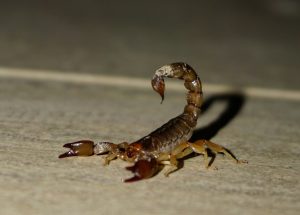
The stripetail scorpion is around 2 ½ inches in length, and they can be recognized for their heavily armored body, bulky pedipalps and tail, and for their striped back. While all scorpion species are venomous, the pain that results from the sting of a stripetail scorpion is comparable to that of a bee sting, but a very small minority of the population may experience a severe allergic reaction to this species venom. Like most scorpion species, the stripetial scorpion burrows beneath objects or debris like wood piles, stones, and tree bark, and in residential areas, these scorpions are well known for establishing harborages within dark and cramped conditions, such as cracks and crevices on walls and flooring.
Full grown adults of this species can enter homes by squeezing through cracks, crevices and other entry points on the exterior walls of homes that are as narrow as 1/16 to ¼ of an inch in width. Once they gain entry into homes, they establish hide exclusively within dark locations, such as closets, attics, beneath furniture, behind baseboards, in shoes, in bedding, and even within drawers. At night, when most residents are fast asleep, stripetail scorpions emerge from their harborages in order to seek out food sources, which mainly consists of insects. In order to keep scorpions from invading homes, outdoor clutter should be minimized, shrubs and other ornamental plants should be well groomed and located at least a foot away from outside walls, and all entry points on exterior walls should be sealed with caulk or another product.
Have you ever sustained a scorpion sting within your home?


